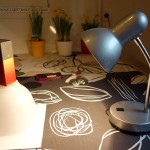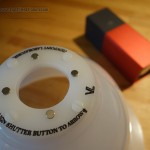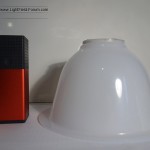Lytro Accessory Review: Nimbus Cloud Dome for Lytro LightField Camera
 When you’re taking pictures with any camera, hard shadows from direct light aren’t always desirable. In some cases, such as product photography, they can be very detrimental to the cause – and this is exactly where the newest third-party accessory for the Lytro LightField Camera comes in: The Nimbus Cloud Dome for Lytro Camera.
When you’re taking pictures with any camera, hard shadows from direct light aren’t always desirable. In some cases, such as product photography, they can be very detrimental to the cause – and this is exactly where the newest third-party accessory for the Lytro LightField Camera comes in: The Nimbus Cloud Dome for Lytro Camera.
The original Nimbus Cloud Dome (funded via Kickstarter) is a portable miniature photography studio. It creates evenly diffused lighting situations without harsh shadows or strong specular highlights, which makes it an ideal tool for small product photography, especially for jewelry and other reflective surfaces.
Viewpoint Laboratories, LLC (think Lytro filter adapter) and Cloud Dome Inc. have partnered up to create a version specifically designed for the world’s first consumer LightField camera.
We’ve taken a close look at the Cloud Dome over the past week, and have put our experiences into the following review.
What’s in the Package?
The Cloud Dome for Lytro Camera comes in a black carry bag that protects it from scratches and transport damage.
The dome itself consists of lightweight, crack-resistant, non-yellowing plastic which diffuses natural light to create soft, evenly distributed lighting inside. It has a height of 4.4 inches (11.3 cm), an inner diameter of 6.2 in (15.7 cm), and weighs 170 g (203 g with the bag). The Lytro Camera is securely attached via four high-strength neodymium magnets, similarly to (but much stronger than) the Lytro lens cap.
Also included in the package is a one page user guide with storage and camera orientation recommendations.
First Use
As with Viewpoint Laboratories’ filter adapter, the integrated magnets provide a solid feeling when the dome is attached to the camera. They’re not quite strong enough to hold the cloud dome on the camera horizontally, but in vertical orientation (which it was designed for) you’d have to shake it quite a bit to loose the accessory by accident.
Due to the slightly off-corner position of the magnets in the camera, there’s one optimal way to attach the dome to the camera, which is easily done by aligning the shutter button to the arrow at the top of the dome.
Once the light diffuser was in place, shadows disappeared and the lighting was very soft and homogeneous. Any filter or diffuser will naturally reduce the actual amount of light available, and that’s sometimes disadvantageous for shutter times. However, the Cloud Dome accounts for that by doubling as a camera tripod. With its stable base, the dome produced well-lit and non-shaky pictures even in low light situations.
It proved to be particularly handy in removing shadows caused by the photographer (i.e. your hands or the camera itself), which can be seen in some of the “without” test photos.
That being said, the Cloud Dome for Lytro also has a few limitations in combination LightField photography.
It was designed for small product photography, and with a height (=maximum distance from the camera) of just over 10 cm, users are limited to Creative Mode. This mode is best for pictures of small things anyways, but we thought we should mention it.
Creating depth – paramount for Refocus and Perspective Shift capability – can be a challenge with an inside volume of about 1-1.5 litres (0.25-0.4 gal): The Cloud Dome only allows the camera to shoot at a 90 degree angle to the flat surface. Also, while being undesired in some situations, the lack of shadows may also limit depth impression. This makes it more important to make sure that the photo subject is tilted if it’s not very three-dimensional.
Test photos
 Due to a distinct lack of sunshine these past days, most of our test pictures were taken with a 60 W light bulb about 40 cm from the objects. We’ll add some pictures taken in bright, direct sunlight when the next opportunity comes up.
Due to a distinct lack of sunshine these past days, most of our test pictures were taken with a 60 W light bulb about 40 cm from the objects. We’ll add some pictures taken in bright, direct sunlight when the next opportunity comes up.
The best camera setting we found was zooming in about halfway in Creative Mode, until the closest points of the scene go out of focus.
https://pictures.lytro.com/me/pictures/607700
https://pictures.lytro.com/me/pictures/607702
https://pictures.lytro.com/me/pictures/607730
https://pictures.lytro.com/me/pictures/607731
More Living Pictures created with the Nimbus Cloud Dome for Lytro Camera are available here: Nimbus Cloud Dome for Lytro Sample Pictures
Conclusion
The Nimbus Cloud Dome for Lytro Camera keeps its promise: it makes small product photography and diffuse lighting a lot easier. It also makes creating refocusable pictures a bit more challenging due to limited space and the vertical orientation, but we felt we got the hang of it after a bit of playing around.
If you’d like to show off small products (in particular with reflective surfaces) using your Lytro camera and an effective, cheap and portable setup, the Nimbus Cloud Dome for Lytro Camera is right for you. Apart from product photography, it can also come in very handy if you’d like to remove harsh contrasts (specular highlights, shadows) from your macro shots.
The Nimbus Cloud Dome for Lytro Camera is available on Amazon.com for 79.00 $. It’s compatible with various Nimbus Cloud Dome accessories (e.g. their Photography Base) that give you more options for lighting.




![Lytro Illum Starts Shipping [In-Depth Reviews, Pictures]](http://lightfield-forum.com/wordpress/wp-content/themes/hueman/assets/front/img/thumb-medium-empty.png)





1 Response